Canna: description, varieties, planting and care

Canna is an amazingly beautiful, spectacular flower and is very loved by summer residents. The high popularity of the plant is due to its good survival rate, a long flowering period and the unpretentiousness of the flower.
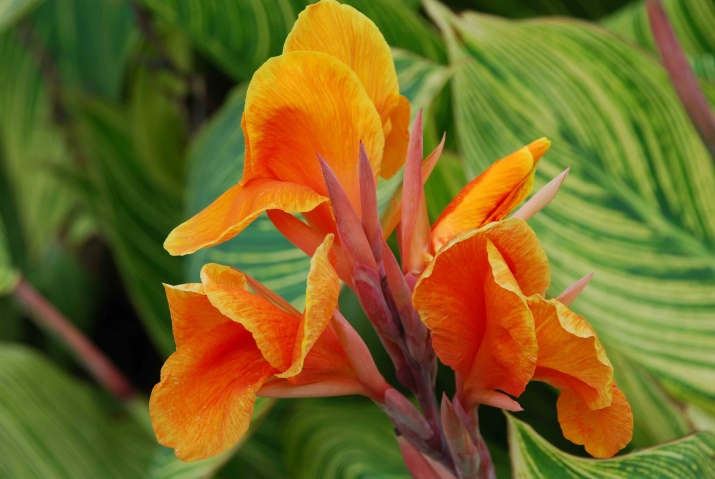



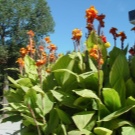

Peculiarities
Canna (from Lat. Canna) is the only representative of the Cannaceae family (from Lat. Cannaceae) and belongs to the order of gingerbreads. The habitat of the plant in the wild is Central and South America, China, Australia, India, Indonesia and the Hawaiian Islands. Thanks to the efforts of the "garden office" of Peter I, the flower was brought to Russia and became widespread. Possessing excellent adaptive qualities, the flower quickly adapts to different ecosystems and grows equally well along water bodies, in mountain gorges and on the coastal plains.
Canna is a perennial herb with large, two-row leaves and a branched root system. The shoots of the flower are thin and erect, sometimes growing up to 3 meters. The oblong or lanceolate leaf plates are large and, in some species, reach 80 cm in length and 15 cm in width.



The flowers of the plant are bisexual, arranged asymmetrically, and are rather large in size. So, in especially large varieties, they reach a diameter of 8 cm, in the rest they vary within 4-6 cm. As for the color, then wild varieties are only red, but artificially bred hybrids are presented in a wide variety of shades and can be white, yellow, orange, gray-blue and even two-color and have specks and a border.
Canna fruits are presented in the form of three-celled loculicidal capsules of oval or cylindrical shape. Their full maturation occurs within 30 days, however, in less favorable conditions, this period can increase to 40 days. Inside the capsules there are round black seeds with a diameter of 6 to 10 mm, arranged in two vertical rows in each of the nests.

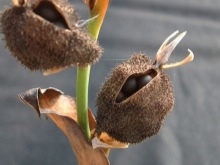

Canna is very actively used by landscape designers to decorate parks and squares, and is also grown as a home flower. In addition to the decorative function, it also has practical benefits: the green parts of the plant are used as feed for livestock, and the rhizomes are a valuable source of starch. In the old days, the aborigines of the tropical part of the American continent cultivated the flower in large volumes, eating its baked starchy rhizomes.
Modern breeders love canna for its ease of growing, drought tolerance, easy care, fast growth, high resistance to most flower diseases, long flowering and high decorative properties. Recently, several varieties have been bred, which, in addition to gorgeous flowers, have a very unusual leaf shape, which only increases the attractiveness of the plant.
Among the disadvantages of canna are low frost resistance and lack of aroma in flowers.


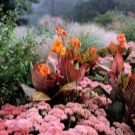



Types and varieties
Today, there are more than 50 species in the genus Cannes, however in ornamental gardening, only 4 are most actively used.
- Canna garden (from lat.Canna x generalis) has a large number of hybrids obtained as a result of interspecific crossing. Breeders managed to get a huge number of varieties with unusual leaves and colorful flowers.
The most common of them are considered "America", having huge purple flowers with a diameter of 12 cm, "The president" - a beautiful hybrid that grows no more than a meter, and "Sunny Beauty" - a plant with lush greenery and showy yellow-cream inflorescences. Of the tall hybrids, the variety can be noted Durban, growing in height up to 3 meters, used for decorating fences and walls of houses.

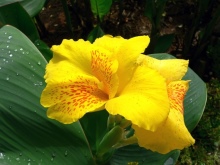

- Canna cochineal (from Latin C. coccinea) has ovoid elongated leaves and large flowers with a diameter of 6-7 cm.
A distinctive feature of the species is a very interesting orange color with slight hints of red. The flowers form loose brushes and look very elegant.


- Canna drooping (from Latin Canna flaccida) grows up to 2 m, characterized by graceful dark green stems, beautiful long bluish leaves and oblong yellow flowers, collected in clusters of 2-3 pieces.
This species is the ancestor of all orchid varieties of cannes and is distinguished by the intricately curved edges of the broad-petal lip.

- Indian canna (from lat. C. indica) refers to a fairly undersized species and grows from 50 cm to 1.5 m. The plant has wide ovoid pointed leaves of a purple hue. Inflorescences are represented by pairs of dull pink flowers. The petal lips are often mottled with gold or pink.
The species is excellent for border and flowerpot cultivation and is distinguished by a very long flowering, lasting from June to late autumn. The most popular among low-growing cannes is the red-leaved hybrid variety called "Discolor" (from Lat. Canna discolor), which is distinguished by burgundy leaves and beautiful orange-red flowers.


Growing at home
Canna is unique in its diversity, which makes it easy to choose both a variety for indoor growing and a mix for flower beds. The flower feels good at home and pleases the owners with lush color and beautiful greenery.


Conditions of detention
Growing cannes in an apartment has a number of specific points, which you should definitely pay attention to.
- For indoor breeding only undersized species should be selected.
- The pot must be large with perforated bottom.
- The plant needs sunlight, therefore, it is necessary to keep the flower near the windowsill.
- Homemade cannes do well at normal room temperature. 20-24 degrees and do not need additional heating.
- The flower prefers moderate air humidity. and does not need spraying. However, this is true only for indoor species, the leaves of which become wet before the rain and can be used as a room "weather station".
- Water the flowers it is possible only with settled water at room temperature. Excess liquid flowing into the pan after watering must be poured out immediately, avoiding waterlogging of the soil.
- Apartment varieties need hibernationwhich lasts 2 months. Before sending the canna to rest, the upper part of the stems is cut off from it, leaving cuttings 15 cm long. Then it is moved to a cool place and stored at a temperature of 6-10 degrees. In May, the cannu is transplanted into the garden for the summer or left at home.
- To preserve the decorative effect of the flower faded inflorescences are promptly cut off. However, many domestic varieties shed wilted flowers on their own, which makes caring for them minimal.



Planting in a pot
You can grow homemade canna from rhizomes. To do this, select a pot of a suitable size so that the rhizomes fit freely in it, and fill it with peat soil 1/2 of the volume, lay the rhizomes and sprinkle them with earth. After 3 weeks, white shoots begin to appear on the rhizomes, a green arrow appears after another 14 days, and the roots begin to actively branch. During this period, the canna is transplanted into a separate pot filled with nutritious soil.
The most important thing at this stage is not to flood the plant and prevent decay of the roots, which, due to their underdevelopment, are not yet able to absorb a large amount of moisture. Watering in this case is replaced by spraying the soil, which is maintained in a slightly moist state. The air temperature in the room should not drop below 20 degrees, otherwise the plant may not take root. After the start of active growth of the green mass, rooting is considered valid and the plant is transferred to a general care regimen.


Very often, summer residents take the canna from the garden plot and transplant it into a potted pot. If the plant is not too tall, then the procedure is not difficult and even beginners can do it. The first step is to prepare a nutritious substrate, which can be purchased at the store, or you can cook it yourself. Store-bought formulations are usable and do not need additional processing. A homemade soil mixture is prepared from sand, peat soil and humus, taken in equal proportions, and must be calcined in an oven at a temperature of 220 degrees for about 20 minutes.
While the soil cools down, expanded clay, broken brick or large pebbles are placed on the bottom of the pot, a layer of sand 5 cm thick is poured, the prepared soil mixture is poured on top, filling the pot by about 1/4 of the total volume. Then they moisten the street plant well, let the water soak in and carefully dig it out, trying not to damage the branched root system. Next, the canna is carefully removed from the ground and transplanted together with an earthen lump into a pot. The voids are filled with the remaining substrate and the soil is carefully tamped. The plant is watered again and left for several days in the same place where it grew before transplanting, allowing it to adapt better in the pot.
Then the flower is taken into the house and transferred to a general care regimen. When growing cannes as an indoor flower, you should know that the root system of the plant grows very quickly. Because of this, the plant needs to be transplanted annually into a larger pot.
However, you should not worry: subject to regular watering, cannes perfectly tolerate transplanting at any stage of the growing season and quickly adapt to a new place.



How to plant in open ground?
When planting cannes in the garden, it is necessary to choose the right site, taking into account the ability of the flower to grow strongly in width. In this regard, the flower bed should be quite spacious so that the distance between adjacent specimens is at least 60 cm.
Cannu is planted in open ground using 2 methods.
- In the first case, seedlings are grown under room conditions in the manner described above. and after the threat of night frosts has passed, they are planted outside. There is no exact timing for transplanting seedlings, you should be guided by the weather. In the central regions, transplanting begins in early or mid-May, in the north and in Siberia - in early June. One of the main requirements for planting pits is the presence of a heating layer.
To do this, hay or rotted manure is placed on the bottom of holes 60 cm deep. Pour 25 cm of fertile soil on top and set seedlings. Then the soil is poured on the sides and carefully compacted, leaving the growth point on the surface. Cannes planting depth is about 15 cm.


- The second method of planting is to plant the rhizomes directly into the open ground. It is used in the southern regions in the second decade of April. The flower bed is broken in a sunny and windproof area and dug deeply. Loose, permeable and organic-rich soil is ideal.The rhizomes are divided into several parts, making sure that each of them has several active buds.
If two of them are located too close to each other, then they are left on the same part without separating. Separation points are well processed pale pink potassium permanganate or charcoal. The resulting cuttings are placed on the bottom of the pits 10 cm deep, sprinkled with a nutritious substrate and poured with warm settled water.


How to care?
Cannu can be used for landscaping summer cottages, parks and squares - the plant perfectly adapts to any conditions and requires a minimum of attention. Flower care includes simple agronomic rules such as watering, fertilizing and preparing for the winter.

Watering
Immediately after planting on a street flower bed, the canna needs moderate watering, since the root system is not yet ready for abundant moisture. More abundant watering is necessary during the flowering of cannes, but the main thing in this matter is not to overdo it and prevent stagnation of water in the root zone. As for indoor species, they are watered as needed, focusing on the state of the topsoil.
For watering, it is advisable to use warm settled water, which helps prevent the development of fungal infections of the root system. In the fall, watering is reduced, and after the beginning of the winter hibernation of the flower, they stop altogether.
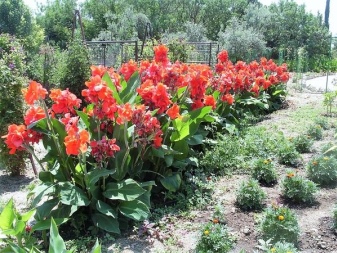

Top dressing
Indoor cannes must be fertilized with complex mineral fertilizers for flowering plants. The first feeding is carried out shortly before the flowering of the plant. The second - after its completion, in the fall. For the winter, feeding is stopped and the flower is allowed to rest.
Street varieties are also fed twice: the first time - when gaining green mass, using for this nitrogen-containing preparations, and the second - shortly before flowering, applying potassium-phosphorus compositions. Every autumn, the flower bed is well dug up, and every 4 years any organic fertilizer is introduced into it, for example, a mullein.


Wintering
Canna does not tolerate lower temperatures very well and often dies from hypothermia. Therefore, before the onset of the first frost, it is dug up and stored until spring in comfortable conditions. At the end of September, the rhizome is dug up and shaken off the ground. After digging, the tubers are placed in a dry, ventilated place and dried for several days. Then they are placed in a bucket of river sand and stored in a cellar. The air temperature in the room should not exceed 10 degrees.
For to preserve rhizomes in a city apartment, you can use a glazed loggia... After digging, the tubers are dried, buried in the sand and taken out to the loggia. In central Russia, including the Moscow region, plants tolerate such wintering well and do not die from the cold. In the northern regions, in the Urals and in Siberia, instead of a loggia, a vegetable refrigerator box is used. Rhizomes are placed in the lower pallet and sprinkled with wood shavings.
If everything is done correctly, the tubers will be perfectly preserved until spring and will sprout quickly.

Reproduction methods
Canna can be propagated in two ways: by seeds and by dividing the bush. Seed method does not guarantee the preservation of parental traits for new plants, therefore it is used very rarely. If the decision is made to use seeds, then they must undergo the necessary training. To do this, they are placed in a freezer for 2 hours, after which they are quickly poured over with boiling water. Sowing begins in mid-February, burying them in nutrient soil scattered over containers.
From above, the landing is covered with glass and removed to a bright and warm place. Every day the glass is lifted and the "greenhouse" is ventilated. The soil is moistened from a spray bottle, preventing it from drying out. A month later, the seeds germinate, after which the man-made greenhouse is dismantled. After a couple of weeks, the seedlings dive into the pots, where they are until the end of May - the time of transplanting plants into open ground.


The second way is to divide the rhizome with a sharp knife. In the second decade of March, the tubers are removed from winter storage and cut into several parts, leaving 2 buds on each of them. The slices are sprinkled with charcoal, after which the cuttings are planted in a greenhouse. As soon as the first leaves appear, the flowers are planted in separate pots, and at the end of May - on a flower bed.

Why doesn't it bloom and what to do?
Sometimes it happens that cannes do not bloom for a long time, although it would seem that there is no objective explanation for this, because the plants receive all the necessary care. There can be several reasons for the lack of flowering, and the most common of them is the violation of the planting dates. If, when transplanting to the street, the seedling was too small, then it will not bloom in the current season.
The second reason is that the plant comes from warm countries, therefore it requires long growing season and a lot of heat. If the summer is too cold, then there will be no flowering either. And the third reason is planting cannes in the shade. The plant needs sunlight and, if it is deficient, may not bloom.

Diseases and pests
Canna is resistant to most flower ailments, however, some diseases are still worth fearing.
- Gray rot appears in conditions of high humidity and low temperatures and appears as brown spots covered with spores. The cause of the disease is a violation of the rules of agricultural technology (excessive watering with cold water).
- Rust also develops from excessive soil moisture. The leaves are covered with brown spots and fall off. The cause of the disease is too much watering.
- Cucumber mosaic manifests itself in a threadlike pattern on the leaves. Infected foliage releases substances that attract pests, and therefore the diseased plant must be removed.

As for pests, Gangnam is annoyed aphids and slugs. The first can be removed with soapy water, and the second can be collected by hand and the ground around the flower can be mulched. The plant is also susceptible to attacks spider mites, scale insects and nematodes, to cope with which any insecticide will help.

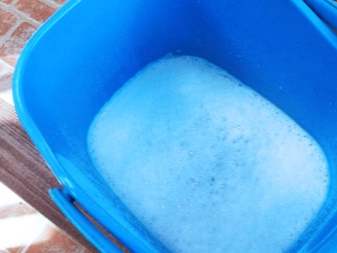
Use in landscape design
Cannes are highly decorative and go well with undersized coleus, seaside rosewood, cerastium, undersized dahlias and marigolds. Large varieties look good as single plantings, while smaller varieties are ideal for growing in flowerpots.
Canna is the centerpiece of the flower bed.


The flower looks good as a frame for a garden path.
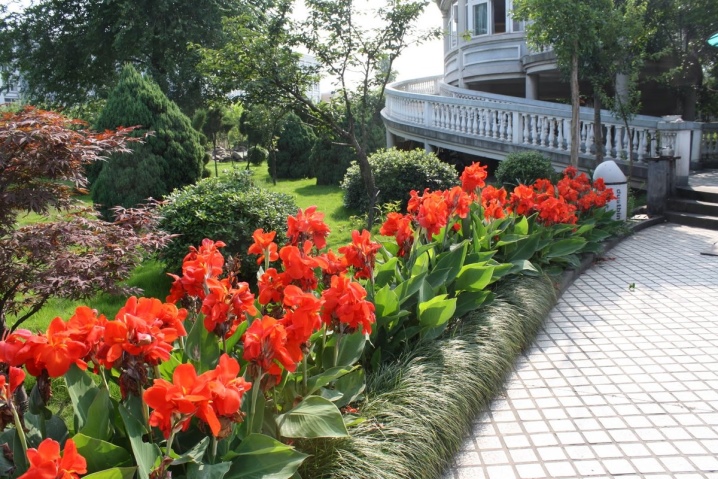
Dense cannes plantings look great against fences and hedges.


Red-leaved canna in a group planting noticeably enlivens the landscape.

Canna in a layered composition looks very advantageous.


For growing and caring for cannes outdoors, see the next video.







































































































The comment was sent successfully.